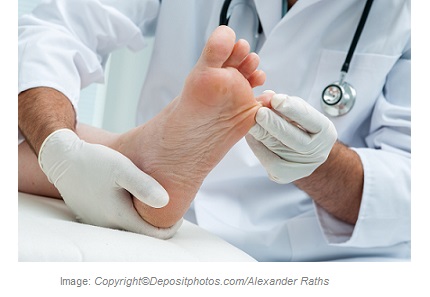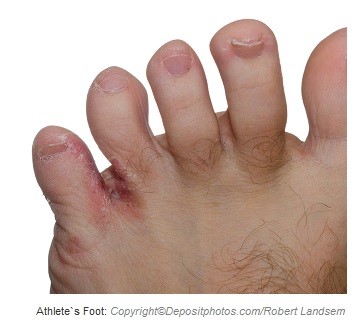Also known as ringworm of the foot, tinea pedis, tinea pedum, and moccasin foot,  athlete’s foot is a fungal infection of the foot. It is a contagious and persistent infection that most commonly affects the toes and toenails.
athlete’s foot is a fungal infection of the foot. It is a contagious and persistent infection that most commonly affects the toes and toenails.
Moisture and warmth resulting from foot sweating facilitate fungal growth. Common places for a person to contact this fungus are gym floors, locker rooms, public or private showers, and hotel bathroom.
The three common fungi that cause athlete`s foot are trichophyton mentagrophytes (mainly in athletes), trichophyton rubrum (mainly in general population), and epidermophyton floccosum
Athlete`s foot is characterized by scaling and thickening of the soles, erythema, burning, itching, cracking between the toes, and yellowish-brown toenails. It affects men three times more than women.
Potential risk factors for developing athlete`s foot are:
- Occlusive shoes.
- Poor hygiene of the feet.
- Weakened immune system for any reasons.
- Diabetes mellitus.
- Long term consumption of antibiotics or corticosteroids.
- Poor digestion and floral dysbiosis.
Management and Nutritional Supports:
General Advices: 
- Using open-toe footwear.
- Frequent changing of socks.
- Keeping the feet dry.
- Drying the spaces between toes after bathing.
- Wearing sandals or well ventilated footwear around the home and outside.
- Washing the feet daily with soap.
Restricted Foods:
- Sugar and sweets. The fungus feeds on sugar.
- Refined carbohydrates.
- Saturated fats. They slow down blood flow to the area.
- Carbonated beverages.
- Foods high in yeast and mold: beers, aged cheese, dried fruits, melons, and peanuts.
- Fruits juices.
Recommended Foods:
- Plenty of water: at least 2 liters a day.
- Legumes.
- Cold water fish: salmon, herring, and mackerel.
- Flaxseeds.
- Chia seeds.
- Hemp seeds.
- Fresh fruits and vegetables.
- Oregon grapes. They contain the alkaloids berberine, berbamine, canadine, and hydrastine, which fight fungus.
- Unsweetened yogurt.
- Garlic.
- Ginger.
- Cinnamon.
Recommended Supplements:
- Tea tree oil: apply the oil topically onto the affected areas.
- Garlic pill: 1000 – 2000 mg a day. Garlic contains ajoene, which is a powerful antifungal agent.
- Probiotics: a product with 5 to 10 billion active organisms per serving.
- Oregano oil (containing over 50% carvacrol): as a capsule, 300 – 500 mg a day or as a liquid form, 0.5 ml twice daily. Oregano oil has a potent antifungal activity.
- Caprylic acid: 2000 – 3000 mg a day. It is a fatty acid with antifungal property.
- Echinacea: 500 – 1000 mg a day.

